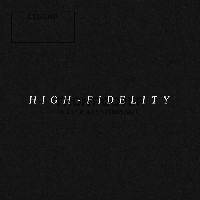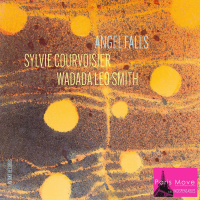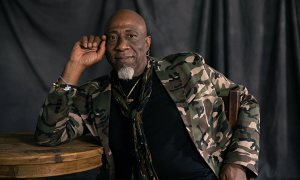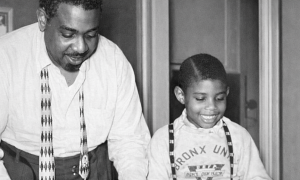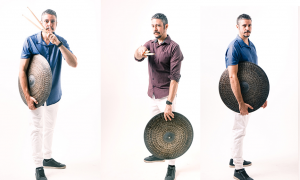Home » Jazz Articles » Interview » Marilyn Mazur: The Song in the Woods
Marilyn Mazur: The Song in the Woods

I get inspired by the variation of energy, by the balance resulting out of it, and by the harmony emanated by stillness.
—Marilyn Mazur
All About Jazz: Do remember your first musical experience?
Marilyn Mazur: When I look back, I have the feeling that I have always been conscious of music, but that's easy to say now. Until I was six years old I lived in New York and I was involved very early, as a three year old, in some musical activities. What I remember is that my mother had a baby-book with percussion sounds and my family kept telling me that I was fascinated by them and wanted to hear them again and again although I became involved with percussion only when I was 19.
What I do remember is that in Denmark we had a record player, I was 7 or 8 years old, and I would close the curtains and retire into a magical world to listen to Stravinsky's Le Sacre du printemps. I had am imaginary teacher who came in to teach me the magical steps of the ballet, her name was Ms. Misticolum, and she looked like an old-fashioned classical dance teacher. That's what I would call my first strong musical experience.
I also think that Le Sacre du printemps has inspired me a lot, because I was fascinated by the ritual aspect of music ever since. As things happen, later on the Danish composer Lars Møller wrote The Rewrite of Spring and invited me to perform together with David Liebman and the Aarhus Jazz Orchestra. So it looks like Le Sacre keeps following me all through my life. I really loved that project.
AAJ: It is not common for a woman to become fascinated with percussion, how did it happen?
MM: I would say that it was rather a gradual process than a sudden revelation. In the early years I was into classical music taking piano and ballet classes. I also started very early writing stories and poems and inventing my own dance steps. So there was a multitude of ways of expressing myself and I didn't know which one I would choose.
I left school and I joined a professional dance-group in Copenhagen. I wasn't playing drums yet at that time, but once, as we were at a festival in Austria drummer Fredy Studer from the group OM said that I must be the drummer in the group, just by looking at the way in which my movements could relate to rhythm.
At that time, this was in 1971, I was actually playing piano, and the festival put me on the program with a solo piano where I was allowed to play my little compositions and sing a few songs. I remember that the people gathered around the piano to listen better. So, my first solo performance was on piano, not on the drums.
I started taking classical piano lessons at the age of 9. As a teenager, I realized that you have to have an education, but at that time you could not study jazz in Denmark, so because I didn't want to be a classical pianist, and my playing was very rhythm-orientated, I decided to study classical percussion for some years at the Conservatory. And that hit home. I just loved it so that I couldn't get away from it.
AAJ: What was so different?
MM: Although at that time I already had my first band as a pianist, playing drums offered me a new kind of freedom. I didn't have to obey all those rules and chords that a pianist had to follow, I could just use my ears, follow, and play as I liked. It gave me the feeling that I could do my own stuff. At that time there were no women around playing drums, especially in the jazz world, there were a few piano players but no drummers. In the following years I changed from piano to drums. Of course I still use the piano, especially when I write music.
AAJ: By the time you started studying music at the Conservatory in Copenhagen you were already active as a composer and a bandleader. What kind of impact had the institutionalized study on your native musicality?
MM: It was good to have it because it put a little order into my musical word. I learned a few theoretical things about arrangements and conducting for example, but for me it's always been two separate worlds. Studying classical piano and writing my own pieces didn't have to do very much with each other. One had to do with the correctness of the classical world, the good way, and the other one had to do with my own, secret world. As I said I was into writing poems and stories and that was a world of magic I wouldn't share with anyone when I was a kid.
The guys would always meet and play together and at that time women were not part of it so I didn't have anyone to share it with. At 15 I would go to a music school and be part of a group or another but before that it was all private and secret. And that followed a long time, even after I started learning things the "correct" way I still had my own territory where despite what they were teaching me, I would follow my own feelings in the world of music. Which I am still doing today.
So, the classical formation is good to have but I am happy that I haven't followed that way. I only had two drum lessons and that's probably why I still do some things in a more complicated way because I never learned it the proper way. As a matter of fact I've never been very good at practicing, that's why I still struggle in some ways. I do it with my feelings and I am happy about it.
AAJ: How did you discover jazz?
MM: My father played classical violin as a hobby and he had a few jazz records at home, like Ray Charles, Ella Fitzgerald and such. I did listen to them but I didn't get very much into it because at that time I was listening to all kinds of music starting with Beatles and finishing with the classics.
My first strong impact with jazz happened when a friend of mine installed me in a dark room at his place, with headphones on, and made me listen to Bitches Brew. At that time I didn't know what I was listening to but I had a very strong experience because I fell immediately into a kind of trance or dream, and I started seeing images. When it was finished he showed me the cover of the album and there were all the pictures I dreamed. I had this dream about an ocean and black and white people, in a kind of magic atmosphere.
So, in a way, the jazz happening before that experience was not my thing. Bitches Brew really set a mark for me, because ever since I see music as a magical way of communication.
AAJ: Do you remember your first performance as a jazz percussionist? Were you nervous?
MM: I wasn't nervous at all because I was not very self-conscious and I didn't know what I was doing wrong. I was an absolute beginner. It was a trio with bass and saxophone. We were playing free jazz in a small club and I played drums. I heard it on tape afterwards and I got depressed because it sounded awful, but I had enjoyed the gig a lot. Sometimes it still happens like that (laughs) but other times you have the feeling that there is not much happening and when you hear the tape it all sounds really good.
AAJ: How were you received as a female musician?
MM: At the beginning I think that the jazz people didn't necessarily take me seriously but I discovered that in the free jazz world there were not the same roles, so all I had to do was follow my instinct and do my thing. And it worked. So I was playing a lot of improvised stuff and it took me a while to realize that it was not the kind of music I wanted to play.
I still like to play improvised music but I chose the drums because I like the grooves, I like the music to take me somewhere. So, I started playing more structured music. And that's exactly when people started paying attention to me.
AAJ: Do you have masters?
MM: Not in the direct sense. As I said, I admire Stravinsky and Miles Davis is a master for everyone because he is in a way at the center of music, but I don't have a role model as far as my instrument goes. When I was young I would listen to people like Nana Vasconcelos but not all he did spoke to me. I get inspired a lot by nature or by things, which don't necessarily have to do with music. I get inspired by the variation of energy, by the balance resulting out of it, and by the harmony emanated by stillness. The variation of colors. I need this changing in the music. I really feel lucky about having been able to choose the direction I was going.
AAJ: Miles Davis, Jan Garbarek, Nils Petter Molvaer, three styles, three epochs, three worlds. What is your musical relation to them? Where lies the distinction from your perspective?
MM: Musically the common trace for them is the strength of being in the music, to have a strong musical expression and center their projects around this presence, so that the musicians playing with them become a part of their musical visions. Especially Miles, who has changed the direction of music. Jan Garbarek has also created his own world. I have listened to Nils Petter Molvaer when he was very young playing with Masqualero and afterwards he joined my group Future Song, so I have a quite different perspective on him. We grew together, so to say, and we kept playing in each other's groups. Jan Garbarek had a greater impact on me because of the lyricism and the strong Scandinavian coloring of his music.
AAJ: Would you tell me the "Miles story"?
MM: Sure. I met Miles for the first time in Copenhagen. He was receiving a prize and was going to play together with the Danish Radio Big Band, so they asked Palle Mikkelborg to write "Aura" for the occasion. Palle invited a few other musicians, and I was one of them. After the show somebody said that Miles liked my playing and wanted to say hello. I gathered my instruments and went to him. I don't think that I was very nervous. At that time I didn't know that I was going to play with him (laughs).
Afterwards, because he really liked the show, we went to the studio to record the pieces, and then I got to really work together with him. We had John McLaughlin as a guest soloist and he was supposed to play on top of the recorded pieces, but we wanted to play live with him. So, somebody said that since I was not afraid of Miles I should go and tell him that. Of course I was afraid, but I said, sure I'll do it. So I went to Miles and told him that we want to play live with John. Of course it didn't happen but he took notice me.
After a while he was playing at the Molde Jazz Festival and I was sitting on the floor in front of the stage listening when he saw me and he shouted, "Marilyn, come play with us!" I didn't do it right away, but after the break he asked me again, so I jumped on the stage and played along. You don't say no twice to Miles.
Later on I heard some people say that Miles was trying to get hold of me but I thought that they were teasing me. And indeed after a few days I got a phone call from him, the famous phone call, asking me if I could be in New York by Wednesday. This was Sunday. Being air sick I tried to avoid traveling by air as much as possible but of course I said yes right away. I packed my stuff and went to New York.
When I got there I went straight into the rehearsal and I remember asking myself it that was really what I wanted, because I was very tired. But after I took a bath it was all like a dream. He told me right away that if I wanted to I could dance on the stage, which surely I did (laugh). It was one of my first encounters with American musicians and they weren't sure what that strange girl coming from Europe had to do with it all, but knowing Miles and the way he encouraged young people, we got along well.
Now when I watch the videos I can see how different from them I was, but nevertheless I was trying to do my best and I learned a lot. So I got the chance to play with these "heavy groovers." I wasn't much of a groover myself at that time, not for a while. In the meanwhile the band was real big, and some concerts got cancelled, so at one point Miles had to scale it down and sent me home. After a year he called me back as the only percussionist in the band. The second time around we had found each other musically and playing was real fun. Nevertheless after a while I felt that it was time for me to go home, so in the end I left Miles and returned to Europe. I wanted to move on with my own music, do my own thing, and I felt that if I waited any longer, I may not be able to do it at all.
AAJ: So what happened afterwards?
MM: I created the group Future Song, I asked all my favorite musicians to join the band, we had the music in the form of seven dreams, one for each musician in the band. And we did a long tour. In the beginning of the nineties, when I just had my son, and just decided that I was going to stay home, I got a call from Jan Garbarek asking if I wanted to join his group.
When you are a curious person like me it is very hard to say no. I really liked his music and as a Scandinavian I could relate better to the nature and the lyricism exalted by it. In other words, I felt at home in his music. He arranged for me to travel with my son on tours, so I joined in right away. It was a wonderful time and Jan became my first priority. We played together until ten years ago, when I got again into doing my thing. At that time I formed the Percussion Paradise group.
Now, to get back to your question about my masters, I think that my music is a mixture of both Miles and Jan, although in a way, I am more chaotic than any of them, because I like a lot of variation and mood changes.
AAJ: Your playing has for me certain playfulness, a suspended balance, generated by the right hand/left hand impact on the instrument, which tremendously enhances the dynamics. Do you see yourself as playful?
MM: Definitely yes. Percussion is a playful instrument and interacting with other musicians is also a playful act, the whole exchange of ideas and moods that takes place, and even the exchange of vibration with the audience. It is all part of the music.
AAJ: You experiment a lot with sound. Did you ever have the feeling that you 'invented' a certain sound?
MM: I don't think in terms of inventing but rather in terms of putting together in a new way. I definitely evolved some sounds. Growing up with music, what you bring into your body will come out later. What I consider very much my kind of sound is playing with gongs and with bells. Of course Jon Christensen was using bells but in my case, coming from the piano, it was important to use also tones, not only beats.
AAJ: What is the main component of improvisational music? How important is spontaneity and intuition?
MM: It depends a lot on what group I am with. For example with Jan Garbarek, the group was very set, so I would know what I am to play and when. I have a set of fixed sounds and all the rest keeps changing. If I have a solo I prefer not to know what I am going to do. In improvisational music it is very important what you get from the people you are playing with, but the mystery part and the magic belongs to the fun of playing too, therefore there are certain things I prefer not to know. I have my bells and I know how they sound but I like discovering quite a lot.
AAJ: Do you remember how you wrote your first composition? Was the rhythmical aspect a main criterion there?
MM: I started composing when I was 12. I would go around the lake and think some tunes. I compose at the piano but not always. The rhythmical aspect is not the only important element. Sometime I may sing a song to myself in the woods and then come back and play it on the piano and then put it on paper. Or I might make a rhythm on drums and the melody would come later but I seldom start by writing the music.
AAJ: Along the years you have formed quite a few groups Future Song, Percussion Paradise, Celestial Circle, Marilyn Mazur Group, Shamania. Why so many? What is the cohesion principle there?
MM: In a way it would be wonderful to just have one group. It would be so easy. But as I said about Future Song, which was one group in the 90-ies, the musicians got into their own projects so at some point you develop multiple constellations so that when one band can't play, some other might. That way it is also easier to participate in festivals more often.
AAJ: What do you consider to be the main characteristic of Nordic Jazz?
MM: The breath, the air, the dreaminess. In Scandinavia there is a strong sense of collectiveness, we play together at the same level and we all communicate when we do music. Music relates a lot to the nature surrounding the people who play it. Denmark is a bit different from Norway, it is more continental and the nature is not so spectacular either. The individual quality of the Norwegian music is deeply connected to the nature there. They have the mountains to separate them and the long winters, so that they can stay inside and dream a lot. That dreaminess gets into their music.
AAJ: Do you have a favorite track or a favorite album?
MM: I like the music I wrote for Future Song, there are some strong tunes there. We revived the band this year and we already had a few concerts in Norway and Denmark.
AAJ: What are you working on?
MM: I just had the debut with my new group Shamania, made up of 12 women. It is a sort of continuation of the project Percussion Paradise, which had only 5 members. So I made a new group with some of the old people but some of the same ideas: a lot of rhythm, a lot of playfulness with a slight ritual dimension.
AAJ: Future plans?
MM: I keep dreaming about making a dance performance. I have a lot of material already. I imagine a scaffold around the stage with the percussion set on the scaffold, and a few dancers doing a performance in the middle. I wanted to do that when I turned 60, this year, but it didn't work out. Maybe when I am 65 (laughs).
Tags
Marilyn Mazur
Interview
Adriana Carcu
Denmark
Copenhagen
Miles Davis
Wayne Shorter
Gil Evans
Ray Charles
Ella Fitzgerald
Nana Vasconcelos
Nils Petter Molvaer
Masqualero
Palle Mikkelborg
john mclaughlin
Jon Christensen
PREVIOUS / NEXT
Support All About Jazz
 All About Jazz has been a pillar of jazz since 1995, championing it as an art form and, more importantly, supporting the musicians who make it. Our enduring commitment has made "AAJ" one of the most culturally important websites of its kind, read by hundreds of thousands of fans, musicians and industry figures every month.
All About Jazz has been a pillar of jazz since 1995, championing it as an art form and, more importantly, supporting the musicians who make it. Our enduring commitment has made "AAJ" one of the most culturally important websites of its kind, read by hundreds of thousands of fans, musicians and industry figures every month.



